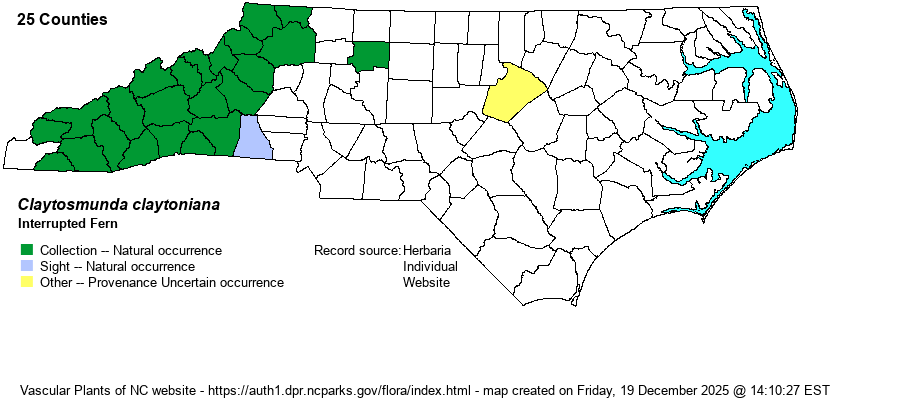| Author | (L.) Metzger & Rouhan | |
| Distribution | Throughout the Mountains, and barely into the Piedmont foothills (such as the South Mountains). Also disjunct records for Forsyth and Wake counties in the central Piedmont. The Wake record is probably not a natural occurrence.
This is a northern species, ranging from eastern Canada south to VA, western NC, northern AL, and AR. Disjunct to south and east Asia.
| |
| Abundance | Fairly common to locally common in the Mountains; rare to locally uncommon in the South Mountains and very rare elsewhere in the western Piedmont. | |
| Habitat | This species favors mesic montane forests, usually on slopes and usually in full to partial shade. It may grow in damp and loamy ground along floodplains, but most populations are at middle to high elevations in oak-hickory forests, balds, edges of high elevation forests, and other places away from cove forests, where it is scarce. Despite its great array of elevations and moisture conditions, it is not as common as one might expect, clearly less common than the closely related Osmundastrum cinnamomeum. | |
| Phenology | Fruits from March to June | |
| Identification | This is a familiar montane fern, generally not confusable with other species if the fertile pinnae are visible. Several stems grow from a clump, each one being about 3 feet tall. The dark-green blades are pinnate-pinnatifid, with about 15-20 opposite pinnae, of which the middle 3-4 pinnae are fertile ones (and thus brown in color). Each sterile pinna is about 4-5 inches long; each contains 10-20 pairs of rounded and deeply cut lobes. The fertile pinnae are much shorter than are the sterile ones. If fertile pinnae are not present, one can easily mistake the species for Cinnamon Fern (Osmundastrum). | |
| Taxonomic Comments | Nearly all references formerly included the species in the genus Osmunda, and many still do. This is the only species in the "new" genus Claytonmunda.
| |
| Other Common Name(s) | None | |
| State Rank | S4 | |
| Global Rank | G5 | |
| State Status | | |
| US Status | | |
| USACE-agcp | | |
| USACE-emp | | |

